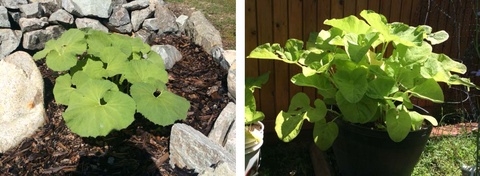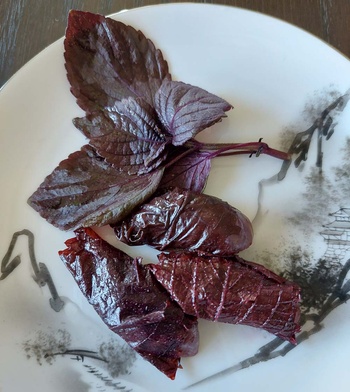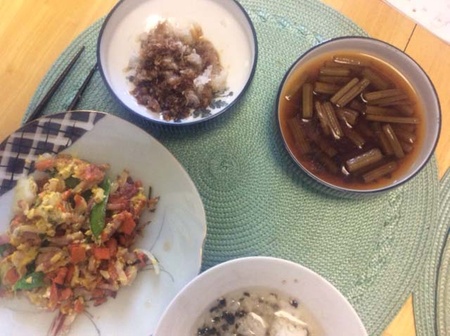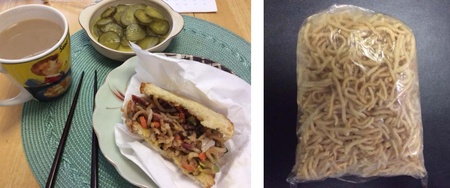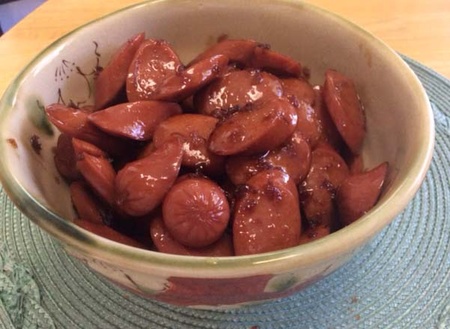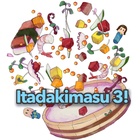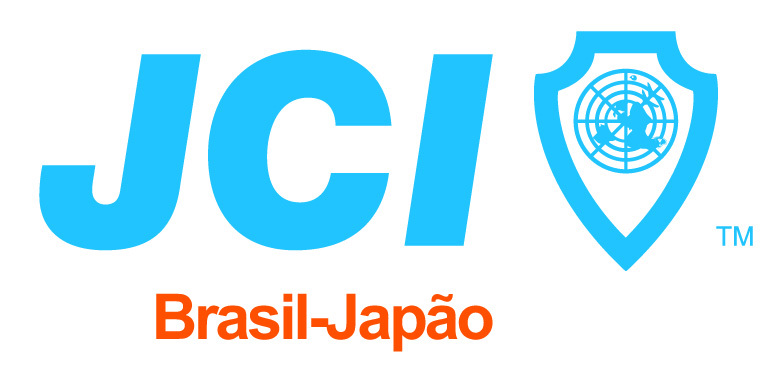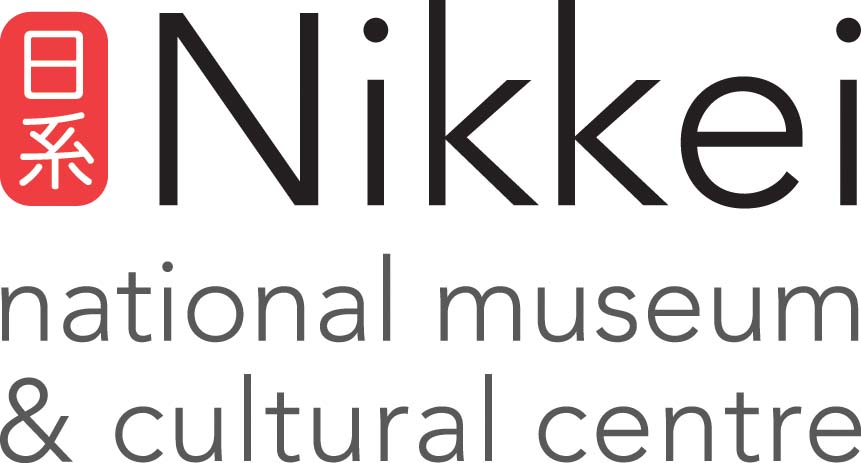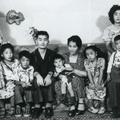I previously wrote an article on Nikkei food that was uniquely Japanese Canadian: kan-ba-lando chow mein that evolved in the coal mining town of Cumberland, B.C., and Denbazuke from New Denver internment camp.
Fuki is symbolic of Japanese immigration. In the late 1800’s, when poor people from rural villages came to Canada or Amerika, for some reason they brought this insignificant root that is grown on the hillside of Japan.
My theory is that perhaps these villagers thought that there wouldn’t be any Japanese food in Canada, and therefore concealed fuki roots onto the ship. Another theory might be that the immigrants surmised that in Canada, they could starve if jobs were not secured early on.
Now, wherever you see fuki, there was sure to be a Japanese Canadian settlement at one time. Fuki and gobo are still visible at the #1 Camp in Cumberland and on Salt Spring Island planted over a hundred years ago. Rows of fuki are evident behind the barn in the former Tashme internment camp from eighty years ago.
Even in the present day, when you buy a house in places like Steveston and former Japanese Canadian farming community like Strawberry Hill in Surrey, B.C., the presence of fuki in the garden is evidence that it was formerly owned by a Nikkei family.
In the early days of Steveston and Powell Street Nihonmachi, Japanese food was available and plentiful. Then, the 1942 mass forced relocation of Japanese Canadians occurred and they were scattered all over British Columbia to internment and labour camps. This is when Japanese food morphed into Nikkei food. People had to improvise and have some semblance of ‘Japanese’ food.
Doukhobors, a community of Russians who believed in peaceful relations, brought fruits and vegetables to the ‘camps’ in the Kootenay. At camps like Kaslo and Greenwood, plots of land were given to grow their own vegetables. Money was scarce back in those days, so many families had ‘Poor Man’s’ lunch and dinner.
When the Japanese Canadians were finally given the rights of a Canadian in April 1, 1949, they still carried on the tradition of the improvised Nikkei food to their new location.
In the 1950's, Japanese Canadians were starting their lives all over again. The word mottainai—meaning ‘not having’—was forever ingrained in their thinking. Therefore, mothers made food from scratch or preserved them. Many families had a small vegetable garden in their backyard. These are some of the Nikkei comfort food that I could remember.
* * * * *
NAN’S UMEBOSHI
Nan (Okano) Tasaka, married to my cousin Bruce, gave me her umeboshi. I loved it so much that I traded a Sidney Crosby Olympic hockey jersey for Nan’s umeboshi! Most people like to keep their recipes secret; therefore, you could only find them in Nikkei recipe books. What makes Nan’s umeboshi so good is that she wraps the plum in shiso leaf.
CANNED SALMON
Again, fisherman like Bruce brought sockeye salmon home to preserve. On a hot summer evening, no one wants to cook. Therefore, canned salmon, tsukemono, nori, and tofu together made a great simple comfort dish. It’s so healthy!
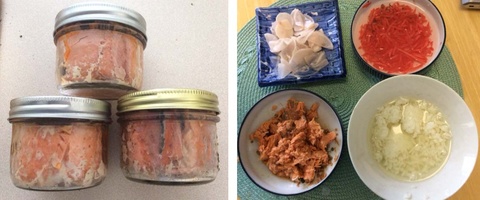
IWA NORI
My brother Kaz used to forage nori on Mayne Island. Now that he’s 89 years old, his daughter, sons, and grandchildren have been trained to pick nori in the cold month of February. The process is quite labour intensive, as I have mentioned in the previous article.
SAYA ENDO AND BACON
This is an all-time favourite of mine, because you can pick the snow peas from your garden, add onion and stir fry with good quality bacon. This is the comfort food that I will always cherish. I never get tired of eating fresh saya endo.
CABBAGE AND SAUSAGE
Kya-be-tsu toh chimpo saa-se-ji is how the Issei called this simple dish. Similarly to sukiyaki, stir fry the breakfast sausage and cabbage with onions, then add sweetened sugar and soy sauce with a dab of grated ginger. Another great comfort food that is easy to make.
BEKON MESHI
Bacon fried rice. Another simple dish to make with leftover rice. Fry the bacon and veggies and add rice. In the early days, it was plain white rice; however, I saw an old Japanese movie where the homeless man befriended a boy, and he made fried rice by adding ketchup. That added colour. Another way is to add eggs first, then rice. In the other frying pan, bacon and veggies are cooked, then mixed into the fried rice.
NIKKEI OMELETTE
Again, using bacon, green onions, chopped carrots, and whatever veggies you have from the garden, pour the eggs added with sugar over the veggies. Some people would mix soy sauce and/or milk. That would go a longer way to feed the children. If you mix the eggs and veggies, it becomes a scrambled-like omelette.
CHOW MEIN SANDWICH
Nikkei style chow mein was a staple diet in the household, because it could feed a large family and children didn’t complain about having to eat vegetables. Chow mein was served at banquets, New Year’s and at festivals. When there would be leftovers, people took them home; again, mottainai was a constant mindset. The next day, chow mein sandwiches would be served for lunch. Re-fried chow mein was especially tasty. In Greenwood, the mein was so good because parents made it from scratch or bought them from a domestic mein-maker in the community.
POOR MAN’S SUKIYAKI
Hamburger was the go-to inexpensive meat to make sukiyaki. My brother, who lived in Japan, chuckles when we make this poor man’s sukiyaki. Normally, you add harusame, spinach, mushroom, tofu, and it has to be freshly grown tomatoes. Then flavour jumps out at you! It is so tasty that I even slurp the juice after eating it. I recently learned that a Japanese chef added tomatoes in his sukiyaki.
The same goes with poor man’s chow mein. Just add hamburger.
OKAYU SPECIAL
This may be unique to old Steveston fishermen families. After attending otera (temple) such as shotsuki (a memorial service), families will go home to make simple comfort food to remind them of their humble beginnings. You add Okayu, rice broth, tsukemono from cabbage or daikon, salted salmon or sato-zuke (sweetened in brown sugar) and nori. You could just imagine how inexpensive it is to make. This is a classic Nikkei comfort food.
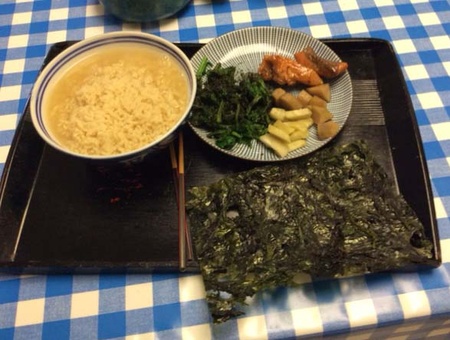
TERIYAKI WEINERS
Another Poor Man’s teriyaki. Substitute chicken or beef with weiners.
Whenever we have Nikkei comfort food, it conjures up so many memories from the past. As we savour this simple dish, we always say, “Totemo assari shi-te iru.” When we consume steak, roast, prawns, lobster, or chicken regularly, the old timers will always go back to the good old days eating fresh vegetables from the garden and eating preserved side dishes. Presently, the cost is only in the meat or fish.
That’s how the Japanese Canadian survivors overcame hardship by improvising their meal with a poor man’s budget. The result? Nikkei comfort food.
© 2022 Chuck Tasaka
Nima-kai Favorites
Each article submitted to this Nikkei Chronicles special series was eligible for selection as the community favorite. Thank you to everyone who voted!


